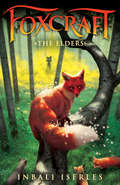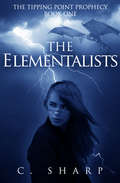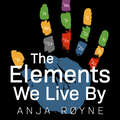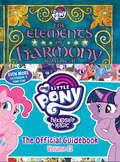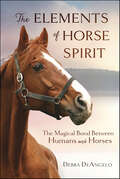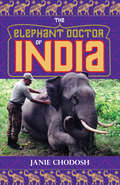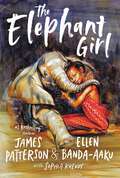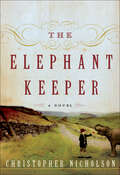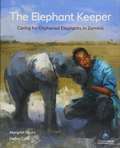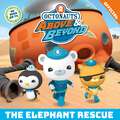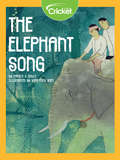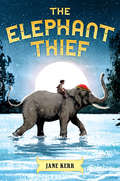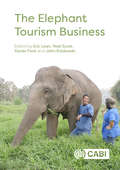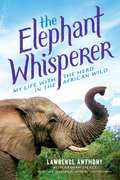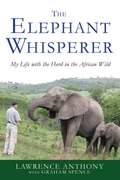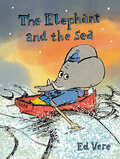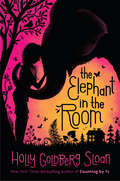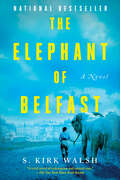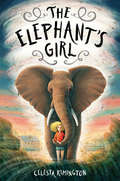- Table View
- List View
The Elders (Foxcraft #2)
by Inbali IserlesThe second book in a thrilling fantasy trilogy starring one of the animal kingdom's most hunted heroes. Foxcraft is full of excitement and heart, and a touch of magic.Isla's search for her missing brother, Pirie, has brought her to the vast Wildlands. The forest is a treacherous place for a fox cub, but Isla is talented in foxcraft -- ancient arts of cunning known only to her kind.Skilled though she is, Isla's grasp of foxcraft is still new. And she's not alone... A cruel and mysterious fox stalks the forest, with the power to enslave others to his will. In order to survive, Isla must learn to trust in the rustic Wildlands foxes.But there are tales of others -- a council of Elders who are masters of foxcraft, and who warily guard its most potent secrets. If Isla wishes to master her gifts and find her brother, then the Elders may be her only hope.
The Electric Eel
by Christopher W. CoatesDid you know that the adult eel is blind? That baby eels have bright blue eyes? That a whopping four-fifths of the eel's body is tail? There are lots more interesting things to know about eels, and you can read about them in this delightful book.
The Elementalists: The Tipping Point Prophecy: Book One (The Tipping Point Prophecy #1)
by C. SharpA tale of dragons and disaster that &“masterfully blends fantasy, teen drama, and a strong message of environmentalism into a white-hot narrative&” (Kirkus Reviews). In small town Virginia, Chloe McClellan&’s sophomore year of high school is rapidly turning into an epic fail. First, she becomes the target of the queen of the It-Girls in gym. Then, she&’s struck by lightning . . . and that&’s when things really start to get weird. There are disconcerting gaps in her memory, and freaky weather seems to follow her everywhere. Either she&’s going insane, or her accident has awoken a terrifying creature from mythology, triggering the final countdown to the extinction of humankind. Rising sea levels, droughts, earthquakes, tornadoes—far below the earth&’s crust, imprisoned in ancient slumber, the elemental powers of the land grow restless . . . Chloe finds unlikely help from a trio of male classmates: the captain of the football team, a flighty stoner with a secret, and an enigmatic transfer student who longs for the sea. All the while, she struggles with the growing realization that dragons exist, and she and her friends may be the only ones who can stop them. In the first book in the epic new Tipping Point Prophecy series, global dragon mythology is reimagined against a backdrop of ecological disaster, high school angst, and the power of the human spirit when working in accord with the elements. &“A cautionary modern tale about climate change and pollution. The realistic, adolescent dramas buffeting [the] clever protagonist . . . are just as well-crafted as the passages on Chinese mythology and five-clawed, flying beasts.&” —Slate
The Elements We Live By: How Iron Helps Us Breathe, Potassium Lets Us See, and Other Surprising Superpowers of the Periodic Table
by Anja RøyneWINNER OF THE 2018 BRAGE PRIZE'[T]his lovely book. An enjoyable sweep through topics ranging from respiration to space exploration -solid science presented in an engagingly human way' Andrew Crumey, author of The Great Chain of Unbeing'Perfect popular science . . . not just a well-written story about the elements, but a book about being human in the world today'Åsmund H. Eikenes, author of Splash: A History of Our BodiesWe all know that we depend on elements for survival - from oxygen in the air we breathe to carbon in the molecular structures of all living things. But we seldom appreciate how, say, phosphorus holds our DNA together or how potassium powers our optic nerves enabling us to see.Physicist and award-winning author Anja Røyne takes us on an astonishing journey through chemistry and physics, introducing the building blocks from which we humans - and everything else in the world - are made. Not only does Røyne explain why our bodies need iron, phosphorus, silicon, potassium and many more elements in just the right amounts in order to function, she also shows us where in the world these precious elements are found (some of them in limited and quickly depleting quantities).Røyne helps us understand how precariously balanced our lives - and ways of living - really are, and to appreciate little known and generally unsung heroes of the periodic table in an entirely new light.
The Elements We Live By: How Iron Helps Us Breathe, Potassium Lets Us See, and Other Surprising Superpowers of the Periodic Table
by Anja RøyneWINNER OF THE 2018 BRAGE PRIZE'[T]his lovely book. An enjoyable sweep through topics ranging from respiration to space exploration -solid science presented in an engagingly human way' Andrew Crumey, author of The Great Chain of Unbeing'Perfect popular science . . . not just a well-written story about the elements, but a book about being human in the world today'Åsmund H. Eikenes, author of Splash: A History of Our BodiesWe all know that we depend on elements for survival - from oxygen in the air we breathe to carbon in the molecular structures of all living things. But we seldom appreciate how, say, phosphorus holds our DNA together or how potassium powers our optic nerves enabling us to see.Physicist and award-winning author Anja Røyne takes us on an astonishing journey through chemistry and physics, introducing the building blocks from which we humans - and everything else in the world - are made. Not only does Røyne explain why our bodies need iron, phosphorus, silicon, potassium and many more elements in just the right amounts in order to function, she also shows us where in the world these precious elements are found (some of them in limited and quickly depleting quantities).Røyne helps us understand how precariously balanced our lives - and ways of living - really are, and to appreciate little known and generally unsung heroes of the periodic table in an entirely new light.
The Elements of Harmony Vol. II (My Little Pony)
by Brandon T. SniderEverything you need to know about the hit TV show, My Little Pony: Friendship is Magic. Character bios, episode guides, and maps are just the beginning! The second volume of the wildly popular My Little Pony: The Elements of Harmony: Friendship is Magic: The Official Guidebook features seasons 4 through 6, highlights of which include Princess Twilight Sparkle, the Castle of Friendship, the Defeat of Lord Tirek, the Equestria Games, the appearance of Starlight Glimmer, the birth of Princess Flurry Heart, and much more! Don't miss the guide to the friendship lessons Twilight Sparkle and her friends have learned-and live your life in harmony with all other creatures! Full color artwork throughout! © 2017 Hasbro. All Rights Reserved.
The Elements of Horse Spirit: The Magical Bond Between Humans and Horses
by Debra DeAngeloDevelop a Deep, Magical Bond with Humanity's Oldest Spirit AllyHarness the amazing spiritual power of horses with this brilliant book on bridging the physical world of horses with the metaphysical realm of Horse Spirit. You'll enhance your life by connecting to equine energy and forging a powerful bond with actual horses and spirit guides.Explore the myths and history of horses as well as the long-lived symbiotic relationship humans have with them. Discover practical horsemanship activities and advice, techniques for working with the four elements, and hands-on exercises to strengthen your energetic connection to horses. This groundbreaking book also helps you choose the best horse for you, both physically and spiritually, and live in harmony with him. Through heartwarming personal stories and well-researched insights, Debra DeAngelo reveals the incredible ways in which horses heal, ground, and teach you to be better in everything you do.
The Elephant Doctor of India
by Janie ChodoshEarly on a January morning in 2015, a young bull elephant touched on a sagging electric line in the Paneri Tea Plantation in the Udalgari District of Assam, India. The elephant's soft-padded feet conducted the current, and the animal fell, kicking in the mud. The local veterinarian called to the scene thought the tusker was going to die. The forest department warden didn't agree. With proper treatment he believed the animal could survive. He called the one person who could help: Dr. Kushal Konwar Sarma, India's beloved elephant doctor.Dr. Sarma's story is part Jane Goodall, part Indiana Jones, and part Dr. Doolittle. The Elephant Doctor of India brings the middle-grade reader into the heart of Assam, a remote land of tea plantations, paddy fields, and ancient forests, to tell the true story of the last viable population of Asian elephants and one man who is dedicated to saving them. Author Janie Chodosh spent time with Dr. Sarma and brings his incredible story—and the lives of these magnificent animals—to readers in classrooms everywhere.
The Elephant Farm / Elephants and Me (Fountas & Pinnell LLI Purple #Level R)
by Isabella TravelerTWO-WAY BOOK The Elephant Farm & Elephants and Me
The Elephant Girl
by James Patterson Ellen Banda-AakuAN INDIE NEXT PICK AND AN AMAZON BEST BOOK OF THE MONTH! #1 bestselling author James Patterson and award-winning author Ellen Banda-Aaku deliver an unforgettable story of a girl, an elephant, and their life-changing friendship—perfect for fans of The One and Only Ivan, Pax, and Because of Winn-Dixie. Clever, sensitive Jama likes elephants better than people. While her classmates gossip—especially about the new boy, Leku—twelve-year-old Jama takes refuge at the watering hole outside her village. There she befriends a baby elephant she names Mbegu, Swahili for seed. When Mbegu&’s mother, frightened by poachers, stampedes, Jama and Mbegu are blamed for two deaths—one elephant and one human. Now Leku, whose mysterious and imposing father is head ranger at the conservancy, may be their only lifeline. Inspired by true events, The Elephant Girl is a moving exploration of the bonds between creatures and the power of belonging.
The Elephant Keeper: A Novel
by Christopher Nicholson“Enchanting . . . a strange tour of late eighteenth-century England, a natural history of elephants and the story of a most unusual friendship.” —The Washington PostA poignant and magical story set in eighteenth-century England, The Elephant Keeper by Christopher Nicholson is the tale of two baby elephants and the young man who accidentally finds himself their guardian. Every reader who was enchanted by Sara Gruen’s Water for Elephants or enthralled by When Elephants Weep will adore Nicholson’s The Elephant Keeper—a masterful blending of historical novel, coming-of-age tale, animal adventure, and love story.“Intensely moving . . . an exceptional novel.” —The Boston Globe“Endearing . . . Like the elephant at its centre, Nicholson’s book is gentle, profound and sweet-natured.” —The Guardian“Bighearted and warm, with a slow-moving kind of grace, the book is very much like the two elephants that inhabit the world of the novel. Elegant and beautiful, the writing is precise and well-paced. The Elephant Keeper is a book that will stay with you long after you have read the last page.” —Raleigh News & Observer“An extended meditation on human needs and how our choices shape a better or lesser existence . . . [A] poignant, heartfelt novel.” —St. Louis Post Dispatch“Christopher Nicholson traces the arc of Tom and Jenny’s surprising journey with delicate empathy. He confronts sex, violence and power, but he does not shy away from less dramatic themes, such as gentleness and companionship, which help to make The Elephant Keeper such a rewarding book.” —Times Literary Supplement“The Elephant Keeper is the best book I’ve read in the past twenty years or so.” —Nikki Giovanni, poet
The Elephant Keeper: Caring For Orphaned Elephants In Zambia (Into Reading, Trade Book #5)
by Margriet Ruurs Pedro CovoNIMAC-sourced textbook <P><P>When teenaged Aaron discovers a baby elephant nearly drowning in the swimming pool at the guest lodge where he works, he acts quickly and manages to save the animal just in time. The rescued baby is brought to an elephant orphanage for care, and given the name Zambezi. Though Aaron has been raised to think of elephants as dangerous to humans and their crops, on a visit to the orphanage, he learns that illegal poaching of these animals is threatening them with extinction, and the orphanage is trying to prevent that from happening. And when Aaron is offered a job at the orphanage, his life is suddenly transformed, as he discovers a bond of friendship with Zambezi and his lifelong vocation as an elephant keeper. <P><P>Inspired by the real-life Aaron and Zambezi at the Lilayi Elephant Nursery in Zambia, author Margriet Ruurs has created a moving story that powerfully demonstrates the plight of endangered animals everywhere. Pedro Covo's stunning illustrations add a level of depth and haunting beauty to the story and the animals. Three nonfiction spreads interspersed throughout the story explore facts about elephants, ivory poaching and elephant orphanages. The back of the book contains ways children can help endangered wildlife. Useful tools include a table of contents and a glossary. This beautifully illustrated nonfiction book spans the curriculum, from life sciences to global awareness to environmental stewardship. It also offers a unique perspective for character education lessons on empathy, caring and responsibility on a larger scale.
The Elephant Rescue (Octonauts Above & Beyond #1)
by Official OctonautsThe Octonauts return with a new global mission - on land! Enlisting their intrepid friends from around the world as Octo-agents - and equipped with a new fleet of land-based Terra Gups - the Octonauts' work is as vital as ever. They will explore far-flung environments, rescue animals that need their help and protect the land and all living creatures.Featuring everyone's favourites from the original series, such as Captain Barnacles and Kwazii Cat, OCTONAUTS ABOVE & BEYOND also introduces lovable new characters like Paani, the water scientist monkey - not to mention their cool new vehicle, the Octo-Ray! Together the crew embark on an exciting mission across the desert of the Skeleton Coast. Can they save a herd of thirsty elephants before it's too late?Each book includes a fact file about some of the amazing creatures featured in the story. Look out for book 2 coming soon.
The Elephant Scientist
by Donna M. Jackson Caitlin O'ConnellIn the sprawling African scrub desert of Etosha National Park, they call her "the mother of all elephants." Camouflaged and peering through binoculars, Caitlin O'Connell--the American scientist who traveled to Namibia to study African elephants in their natural habitat--could not believe what she was seeing. As the mighty matriarch scanned the horizon, the other elephants followed suit, stopping midstride and standing as still as statues. The observation would be one of many to guide O'Connell to a groundbreaking discovery!<P><P> Winner of the Sibert Medal
The Elephant Song
by Pamela D. GauciAung lives in a small village in Burma (Malaysia) and spends his free time tending to the village elephants. Beyond his village, the world is at war, and invading Japanese troops are on their way.
The Elephant Thief
by Jane KerrBased on real events, this is a miraculous story of a boy who befriends a famous elephant during a race against time and villains!When young pickpocket Danny accidentally buys an elephant at an auction, he finds himself swept up on an unforgettable adventure. Offered a job by a zookeeper, all he has to do is ride Maharajah from Edinburgh to Manchester in one week.Everyone in the country is watching, even the Queen, but the journey soon proves to be filled with drama and danger. A rival zookeeper will stop at nothing to make sure they fail, and soon Danny's shady connections from his past threaten to overturn the mission...Can Danny win the trust and friendship of the elephant and guide him home? Can the two of them stick together through the odds and win the day?
The Elephant Tourism Business
by Eric Laws Anja Pabel Rebecca Winkler Clive Phillips Eric Brymer Andrew McLean Professor Noel Scott Melville Saayman Daniel Turner Professor Xavier Font Mucha Mkono Ann Suwaree Ashton Liv Baker Sumanth Bindumadhav Sarah Blaine Naphawan Chantradoan Saranphat Chotmanakul Qingming Cui Susanna Curtin Charlotte Day Nilakshi Galahitiyawe Vivek Gurusamy Nicole Hausler Jeffrey Dale Hobbs Claire Jenkinson Professor John Koldowski Naut Kusters Shilpa Mahbubani Somyot Ongkhluap Piengpen Na Pattalung Kannapa Pongponrat Bongkosh Rittichainuwat John Edward Roberts Andrea Saayman Jan Schmidt-Burbach Alokparna Sengupta Vinathe Sharma-Brymer Ramona Strödecke Daminda Sumanapala Marjorie Van Strein Isabelle Wolf Honggang XuElephant tourism is a growing activity in many countries across Asia and Africa and is popular with tourists from all parts of the world. Elephant tourism has grown rapidly, providing the only viable way for elephants and their owners to survive since the banning of logging. Old logging camps have been developed into sanctuaries for some elephants, but many other camps were established as entertainment centres, resulting in serious welfare issues for the elephants and their mahouts. The profits from elephant tourism in Asia have encouraged African operators to follow a similar business model. This book draws attention to the need for a comprehensive and rigorous focus on local solutions to improve the welfare of captive elephants, their mahouts and local residents, and to enhance tourists' experiences of elephant tourism. It achieves this by: - Critically reviewing recent research into elephant tourism. - Providing contemporary analytical case studies of elephant tourism policy and practice. The Elephant Tourism Business will contribute to a better understanding of how elephant tourism is organised, regulated and promoted, both in elephant areas and tourist origin countries. It identifies priorities for future research into elephant tourism and provides a unique, authoritative resource for researchers, elephant managers and administrators, and tourism managers. The book will be of interest to academics and practitioners with backgrounds in conservation, the environment, tourism and veterinary sciences, and will appeal to tourists keen to experience elephants in person.
The Elephant Whisperer (Young Readers Adaptation): My Life with the Herd in the African Wild
by Thea Feldman Lawrence Anthony Graham SpenceWhen Lawrence Anthony was asked to accept a rogue herd of elephants in his reserve in South Africa, it was the last chance for these elephants. If Anthony didn’t take them, they would be shot. But he had no experience with elephants at all. What was he to do?Take them on, of course!What follows is an exciting and heartwarming series of adventures, in which Anthony learns about elephants and becomes part of their family. Full of both triumph and tragedy, this fascinating account of living with the majestic elephant is unforgettable.
The Elephant Whisperer: My Life With the Herd in the African Wild
by Lawrence Anthony Graham SpenceLawrence Anthony devoted his life to animal conservation, protecting the world's endangered species. Then he was asked to accept a herd of "rogue" wild elephants on his Thula Thula game reserve in Zululand. His common sense told him to refuse, but he was the herd's last chance of survival: they would be killed if he wouldn't take them. In order to save their lives, Anthony took them in. In the years that followed he became a part of their family. And as he battled to create a bond with the elephants, he came to realize that they had a great deal to teach him about life, loyalty, and freedom. The Elephant Whispereris a heartwarming, exciting, funny, and sometimes sad memoir of Anthony's experiences with these huge yet sympathetic creatures. Set against the background of life on an African game reserve, with unforgettable characters and exotic wildlife, Anthony's unrelenting efforts at animal protection and his remarkable connection with nature will inspire animal lovers and adventurous souls everywhere.
The Elephant and the Bad Baby
by Elfrida VipontOne day the Elephant went for a walk and met a Bad Baby. And the Elephant said to the Bad Baby, "Would you like a ride?" And the Bad Baby said yes. So the Elephant stretched out his trunk, picked up the Bad Baby, and put him on his back. And they went rumpeta, rumpeta, rum-peta, all down the road. Before long the Elephant had helped himself to all kinds of good things to eat, which he shared with the Bad Baby. The people whose food they had taken came running after them, until suddenly the Elephant realized that the Bad Baby had forgotten his manners. First published in 1969, this hilarious cumulative story, with its exuberant illustrations. by award-winning artist Raymond Briggs, has been out of print for some years. It is now available again to enchant a whole new generation of small readers.
The Elephant and the Sea
by Ed VereAn inspiring, seafaring fable about a determined and brave elephant who reaches for his dreams, from New York Times bestselling author-illustrator Ed Vere."There is only one thing I want to do . . . So I will do it!"Gabriel the elephant dreams of being part of the lifeboat crew in his seaside town, but he is too young, and too little. But soon, Gabriel grows up and he is too . . . BIG! Disappointed but undaunted, Gabriel makes a plan. He hammers and chops, saws and sands, and builds his very own boat.One night, a great storm hits, and it's Gabriel's time to shine, pulling his oars alone against the crashing waves to save a crew in peril.Young children will love rooting for underdog Gabriel and will draw inspiration from his determination to achieve his dreams despite hurdles and setbacks. The Elephant and the Sea is a perfect gift for anyone setting out on a new path, encouraging them to face life&’s obstacles with optimism.
The Elephant in the Room
by Holly Goldberg SloanFrom the New York Times bestselling author of Counting by 7s comes a heartfelt story about "the importance of compassion and bravery when facing life&’s challenges&” (Kirkus) for fans of The One and Only Ivan and Front Desk.It's been almost a year since Sila's mother traveled halfway around the world to Turkey, hoping to secure the immigration paperwork that would allow her to return to her family in the United States.The long separation is almost impossible for Sila to withstand. But things change when Sila accompanies her father (who is a mechanic) outside their Oregon town to fix a truck. There, behind an enormous stone wall, she meets a grandfatherly man who only months before won the state lottery. Their new alliance leads to the rescue of a circus elephant named Veda, and then to a friendship with an unusual boy named Mateo, proving that comfort and hope come in the most unlikely of places. A moving story of family separation and the importance of the connection between animals and humans, this novel has the enormous heart and uplifting humor that readers have come to expect from the beloved author of Counting by 7s.
The Elephant of Belfast: A Novel
by S. Kirk WalshInspired by true events, this vivid and moving story of a young woman zookeeper and the elephant she's compelled to protect through the German blitz of Belfast during WWll speaks to not only the tragedy of the times, but also to the ongoing sectarian tensions that still exist in Northern Ireland today—perfect for readers of historical and literary fiction alike.Belfast, October 1940. Twenty-year-old zookeeper Hettie Quin arrives at the city docks in time to meet her new charge: an orphaned three-year-old Indian elephant named Violet. As Violet adjusts to her new solitary life in captivity and Hettie mourns the recent loss of her sister and the abandonment of her father, new storm clouds gather. A world war rages, threatening a city already reeling from escalating tensions between British Loyalists and those fighting for a free and unified Ireland. The relative peace is shattered by air-raid sirens on the evening of Easter Tuesday 1941. Over the course of the next five hours, hundreds of bombs rain down upon Belfast, claiming almost a thousand lives and decimating the city. Dodging the debris and carnage of the Luftwaffe attack, Hettie runs to the zoo to make sure that Violet is unharmed. The harrowing ordeal and ensuing aftermath set the pair on a surprising path that highlights the indelible, singular bond that often brings mankind and animals together during horrifying times. Inspired by a largely forgotten chapter of World War II, S. Kirk Walsh deftly renders the changing relationship between Hettie and Violet, and their growing dependence on each other for survival and solace. The Elephant of Belfast is a complicated and beguiling portrait of hope and resilience--and how love can sustain us during the darkest moments of our lives.
The Elephant's Child
by Rudyard Kipling Geoffrey PattersonThis energetic book takes young readers on a journey with a very curious baby elephant who has one question on his mind: What do crocodiles eat for dinner? But whenever he asks this question, he gets a spanking! Though he's never seen a crocodile before, the baby elephant sets out to the banks of a river to find the answer to his question. Geoffrey Patterson has simplified the original text for a younger audience without losing any of Kipling's much-loved turns of phrase.
The Elephant's Girl
by Celesta RimingtonA magical adventure about a girl with a mysterious connection with the elephant who saved her life, for fans of Katherine Applegate and Jennifer Holm. <p><p> An elephant never forgets, but Lexington Willow can't remember what happened before a tornado swept her away when she was a toddler. All she knows is that it landed her near an enclosure in a Nebraska zoo; and there an elephant named Nyah protected her from the storm. With no trace of her birth family, Lex grew up at the zoo with Nyah and her elephant family; her foster father, Roger; her best friend, Fisher; and the wind whispering in her ear. <p> Now that she's twelve, Lex is finally old enough to help with the elephants. But during their first training session, Nyah sends her a telepathic image of the woods outside the zoo. Despite the wind's protests, Lex decides to investigate Nyah's message and gets wrapped up in an adventure involving ghosts, lost treasure, and a puzzle that might be the key to finding her family. As she hunts for answers, Lex must summon the courage to leave the secure borders of her zoo to discover who she really is--and why the tornado brought her here all those years ago.
